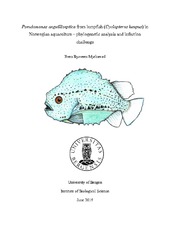Pseudomonas anguilliseptica from lumpfish (Cyclopterus lumpus) in Norwegian aquaculture – phylogenetic analysis and infection challenge
Master thesis
Permanent lenke
https://hdl.handle.net/1956/20365Utgivelsesdato
2019-06-22Metadata
Vis full innførselSamlinger
- Master theses [270]
Sammendrag
The large-scale production and use of lumpfish (Cycloperus lumpus) as a biological delousing agent in Norwegian aquaculture presents novel pathogenic issues. The bacterium Pseudomonas anguilliseptica has in recent years emerged as a serious threat to production of lumpfish in Norway. Little is known about the population structure of this bacterium despite its association with disease in a wide range of different fish species throughout the world. The phylogenetic relationships between 53 isolates, primarily derived from lumpfish, were reconstructed by Multi-Locus Sequence Analysis (MLSA) using nine housekeeping genes (rpoB, atpD, gyrB, rpoD, ileS, aroE, carA, glnS and recA). An infection challenge was also conducted to investigate the pathogenic nature of the bacterium associated with disease in lumpfish. Intraperitoneal (i.p.), intramuscular (i.m.) and cohabitant (exposure of naïve fish to horizontal infection from i.p. and i.m. challenged fish) challenge models were established utilizing an isolate of epidemiological relevance for Norwegian lumpfish production. MLSA analysis revealed a high degree of relatedness between the studied isolates, yet ultimately described three major phylogenetic clusters consisting of seven different genotypes. While four genotypes were identified amongst Norwegian lumpfish isolates, the majority of isolates, irrespective of geographic origins belonged to a single genotype. This suggests the existence of a dominant genotype associated with disease in production of lumpfish in Norwegian aquaculture. The observed mortality amongst both i.p/i.m and näive cohabitant fish suggests that the bacterium constitutes a ‘primary’ pathogen in lumpfish. Elucidation of the population structure, and the pathogenic nature of the bacterium associated with production of lumpfish in Norway, has provided valuable information of relevance for future vaccine development.
